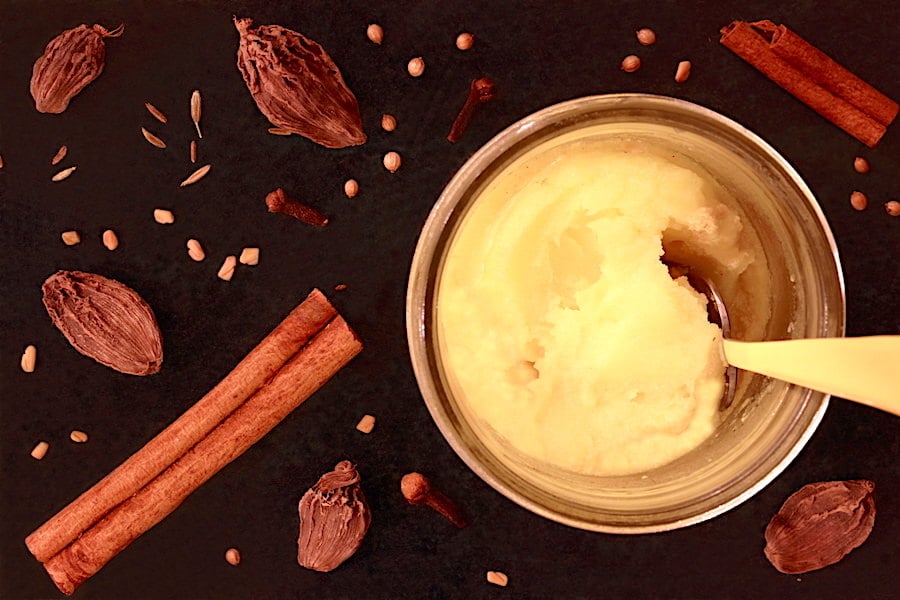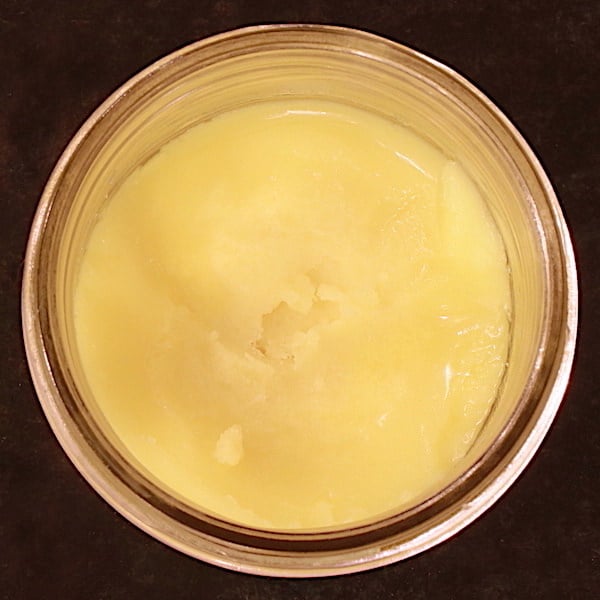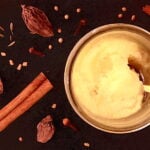Prepare this vegan niter kibbeh (Ethiopian spiced butter) recipe to have on hand for making Ethiopian collard greens and other flavor infused dishes. I’m in love with this spiced butter – it smells and tastes sooooo good! This recipe makes about a cup, and it keeps well in the refrigerator.
As a reminder, spices are the roots, bark, and seeds of various plants. They contain a variety of nutrients, phytonutrients and properties – so including plenty of spices (and herbs) into your diet adds health benefits as well as adding to your culinary pleasure. Recipes that are spiced with a heavy hand (all Ethiopian recipes) contain a boost of flavor and nutrients.

Method Overview
- Melt vegan butter with onions, garlic, ginger
- Pan-toast spices
- Add spices to butter and let them infuse over low heat
- Strain veggies and spices; pour into jar and refrigerate
Vegan Niter Kibbeh (Ethiopian Spiced Butter)
Recipe makes about 1 cup
Servings: 1 cup
Equipment
- small cast iron skillet, or other heavy bottomed skillet
- small saucepan (or double boiler)
- fine-mesh strainer and cheesecloth
Ingredients
- 8 ounces vegan butter, such as Miyoko's Cultured Vegan Butter
- 1/4 cup chopped yellow onion
- 2 Tablespoons minced garlic cloves
- 2 Tablespoons minced ginger root
Spices
- 1/4 teaspoon ground turmeric
- 1/2 teaspoon cumin seeds
- 1 teaspoon fenugreek seeds
- 1 teaspoon coriander seeds
- 1 teaspoon whole black peppercorns
- 1 cinnamon stick (Ceylon cinnamon if possible)
- 3 whole cloves
- 3 black cardamom pods, such as Spicely Organics brand
Instructions
- In a small saucepan, melt the butter over low heat with the onions, garlic, and ginger root.
- In the meantime, warm up a dry cast iron skillet, or other heavy-bottomed skillet, over low heat. Add the spices and raise the heat to medium-high. Toast the spices, constantly stirring, for a couple of minutes or until they start to become fragrant.
- Add the toasted spices to the pan with the melted butter and stir. Allow the spices to infuse into the butter, over low heat, for about an hour. You want the butter to be good and warm, but no need to simmer.
- Line a fine mesh strainer with cheese cloth and set it over a small bowl. Pour the butter into the cheesecloth lined strainer so that it drains into the bowl. Squeeze the cheesecloth to wring out all of the spiced butter.
- Pour the spiced butter into a half-pint mason jar and cap. Store it in the refrigerator.
Notes
- If necessary, refined coconut oil or olive oil can be used in place of vegan butter.
- As an alternative, use a double boiler for infusing the spices into the butter.




11 Comments
Anonymous
April 28, 2021 at 10:20 pmSounds delicious!
Judy DeLorenzo
April 28, 2021 at 11:04 pmIf you try it let us know what you think 🙂
Amie
August 1, 2022 at 7:16 pmDelicious exactly as is; have also subbed fresh turmeric. Make a double batch ❤️
Judy DeLorenzo
August 1, 2022 at 10:31 pmSo glad you are enjoying this recipe!
Najia
October 5, 2022 at 8:23 pmThanks for the recipe! Worth noting that the black cardamom you’ve linked to is in fact Indian / Nepal black cardamom (Amomum subulatum), which has a strong smoky, menthol-like smell and taste—when Ethiopian recipes call for black cardamom, they mean what is called korerima in Amharic (Afromomum Corrorima), which is far milder. But perhaps harder to find for those outside of Ethiopia, unless you order it online!
Judy DeLorenzo
October 6, 2022 at 11:56 amHello Najia,
Thanks so much for pointing out there are two types of black cardamom, one meant for Indian cooking and one meant for Ethiopian cooking! I will try and locate the latter before I make this recipe again to see the difference 🙂
Matt Springer
January 9, 2023 at 4:20 amI haven’t actually tried the recipe so I can’t rate it, but I’m trying to find out whether Ethiopian cooking traditionally uses “cinnamon” that is true Ceylon cinnamon or one of the cassia varieties (like Saigon cinnamon, Indonesian Korintje cinnamon, or Chinese cinnamon). It seems the few photos I have seen of “cinnamon” on pages about Ethiopian cooking are showing cassia sticks (and so does your photo above), but I noticed your recipe specifically called for Ceylon. What do people actually use in Ethiopia? (Specifically, I have a recipe for doro wat that calls for cinnamon and I don’t know what the authentic flavor would need.) Thanks very much!
Judy DeLorenzo
January 10, 2023 at 11:18 amHi Matt and thanks for the question. I’m sorry but I don’t know which type of cinnamon is traditionally used in Ethiopia. I prefer to use Ceylon in my cooking because it contains less coumarin, which is supposed to be toxic in high amounts and hard on the liver in general. I hope this helps. Let us know what you think of the recipe after you try it 🙂
Anonymous
January 14, 2023 at 6:04 amThank you!
Lily
January 19, 2023 at 11:49 pmFantastic recipe. Thanks so much 🙂
Judy DeLorenzo
January 20, 2023 at 12:06 amYou’re welcome! I’m glad you like it 🙂